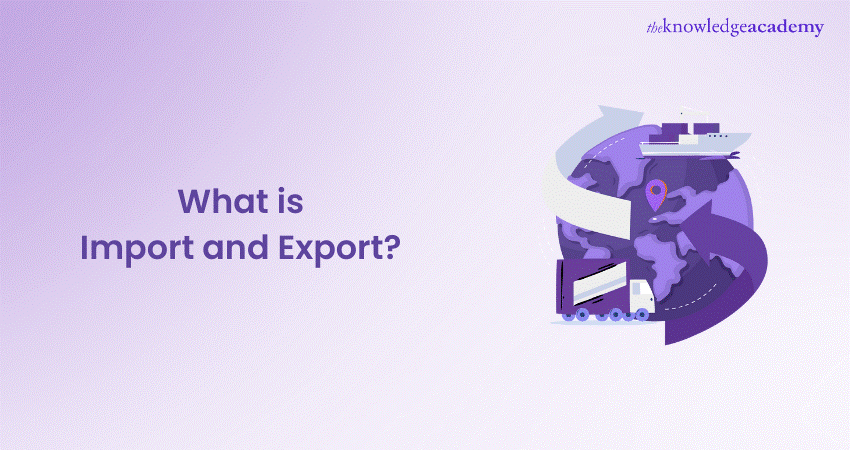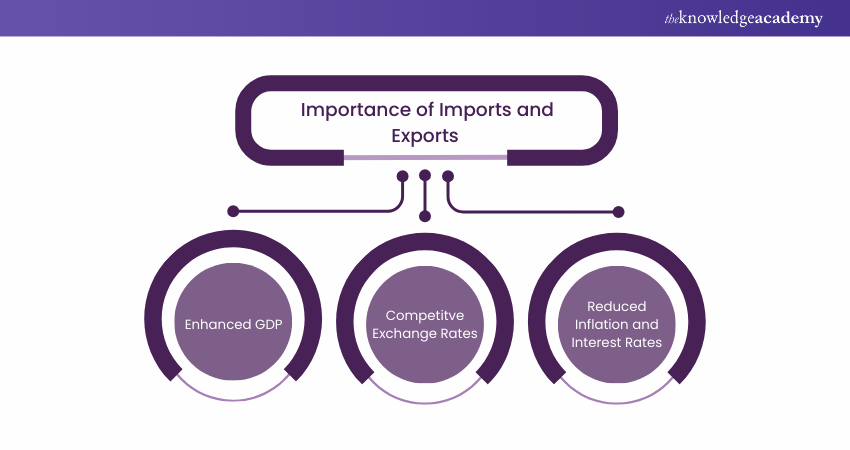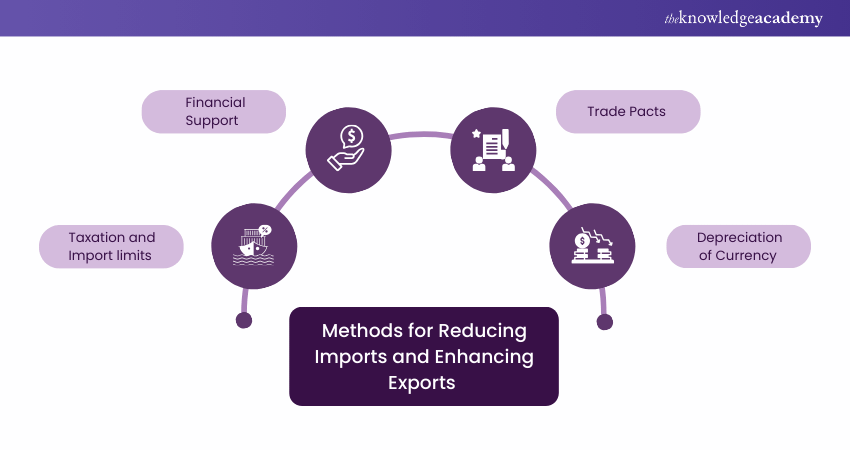We may not have the course you’re looking for. If you enquire or give us a call on +91-181-5047001 and speak to our training experts, we may still be able to help with your training requirements.
We ensure quality, budget-alignment, and timely delivery by our expert instructors.

A large part of the global population is involved in international and local trade, either as buyers or sellers of goods and services. However, they do not know What is Import and Export exactly. These terms are essentially used to describe the movement of goods and services across national boundaries. But their process is much more intricate and complex. In this blog, we will give you an overview of What is Import and Export, and why they are important for the global economy and society.
Table of Contents
1) What is Import?
2) Understanding What is Export
3) Why are Imports and Exports Crucial?
4) Methods for Reducing Imports and Enhancing Exports
5) What is an Example of Export?
6) What Does Tariff Mean?
7) Conclusion
What is Import?
Imports are goods and services purchased by businesses or consumers from another country. This results in an outflow of funds from the purchasing country. While most nations strive to export more than they import to boost domestic revenue, a high level of imports can also signal a growing economy.
This is particularly true if the imports consist of productive assets like equipment and machinery, which can enhance the receiving country's economic productivity. For example, a paper manufacturing company in the UK might choose to import a new machine from Italy, highlighting the difference between import and export. This approach is often more cost-effective than building the machine themselves or purchasing it from a domestic supplier.
Once the machine is installed, it can increase the company's production capacity for paper products. This can boost their revenue and let them to export more goods in the future.
Understanding What is Export
In its broadest sense, Export entails the pivotal economic activity of sending goods, services, or information from one country to another. This dynamic process is instrumental in fostering global trade, underpinning the exchange of commodities, expertise, and cultural assets across international borders.
Exports are a linchpin for economic growth, enabling nations to leverage their comparative advantages and participate actively in the global marketplace. Goods form the backbone of Exports, ranging from manufactured products to raw materials. They contribute significantly to a country's revenue and economic vitality.
Additionally, the Exportation of services, including technology, finance, and consultancy, has become increasingly prominent, exemplifying the diversification of Export portfolios. Exports are not merely transactions; they embody strategic economic relationships between nations. By engaging in Export activities, countries meet international demand and enhance their financial resilience and competitiveness. Successful Export-oriented economies often cultivate innovation, quality standards, and efficiency to gain an edge in the global market.
The concept of Export extends beyond economic realms; it encapsulates the dissemination of culture, ideas, and technological advancements. The act of Exporting becomes a channel for cross-cultural exchange, fostering mutual understanding and collaboration on a global scale.
Enhance your knowledge of the current trends and policies with our Industry Training - join today!
Why are Imports and Exports Crucial?
Benefits of Import and Export highlight that exports and imports are key parts of a country's economy. Together, they form the balance of trade, which shows the economic health of a nation. In a strong economy, both exports and imports grow, indicating sustainability and fostering long-term economic growth.
Trade Imbalance:
Trade Surplus: Occurs when exports exceed imports, leading to a net inflow of money from abroad. This usually signals a healthy economy.
Trade Deficit: Happens when imports are more than exports, causing a net outflow of money. This can occur due to:
a) Lack of skill
b) Limited resources
c) Preference for cheaper foreign products
To fully grasp the significance of exports and imports in economics, it's helpful to understand their impact on a country's Gross Domestic Product (GDP), Exchange Rate, Inflation Level, and Interest Rates. Here is more information on each of these topics:

Gross Domestic Product (GDP)
Imports and Exports are integral components contributing to a nation's Gross Domestic Product (GDP). GDP is a key metric measuring a country's economic output. Exports directly contribute to GDP by representing the value of goods and services produced domestically but consumed internationally.
Conversely, while subtracted from GDP calculations, Imports reflect the demand for foreign products, showcasing the interconnectedness of economies. A healthy balance of Exports and Imports indicates a robust economy, demonstrating that a nation actively participates in global trade. If you are looking to understand a country’s economic strength, knowing how to calculate GDP is essential, as it considers the impact of both imports and exports.
Exchange Rates
The relationship between Imports, Exports, and exchange rates is intricate. Exporting goods and services enhances a country's foreign exchange reserves, positively influencing its currency's value.
On the other hand, Imports may lead to a domestic currency depreciation if the demand for foreign goods outstrips Exports. Exchange rates, in turn, impact the cost and competitiveness of a nation's products in the global market. By actively managing these relationships, countries can influence their economic standing and maintain a competitive edge in International Trade.
Inflation Levels and Interest Rates
The retreat and flow of Imports and Exports also influence a nation's inflation and interest rates. A surge in Imports may contribute to inflationary pressures, as increased demand for foreign goods could outpace domestic supply.
Governments may adjust interest rates as a monetary policy tool to manage inflation. Additionally, a healthy Export sector can generate foreign income, potentially reducing the need for higher interest rates to attract foreign capital.
Learn more about communicating effectively with our Facilitation Skills Training – register now!
Methods for Reducing Imports and Enhancing Exports
In International Trade, nations employ various strategies to balance their trade deficits, aiming to reduce Imports and bolster Exports. Here are four essential methods used by countries to achieve this delicate equilibrium:

1) Taxation and Import Limits
Governments often resort to imposing taxes and Import limits to curb the inflow of foreign goods and encourage the consumption of domestically produced items. Tariffs and taxes levied on imported goods can make foreign products more expensive, providing a competitive edge to local industries.
Additionally, Import quotas set restrictions on the quantity of specific goods that can be Imported, safeguarding domestic enterprises from excessive foreign competition. While these measures can protect local businesses, they should be carefully calibrated to avoid retaliatory actions and disruptions in global trade dynamics.
2) Financial Support
Providing financial support to domestic industries is a proactive approach to enhancing Export competitiveness. Governments may offer subsidies, grants, or low-interest loans to industries engaged in Export activities. These financial incentives can offset production costs, making locally produced goods more competitive internationally.
Furthermore, investing in research and development to foster innovation can create high-quality, value-added products that appeal to global consumers. Countries can strengthen their Export capacity and diversify their product offerings by strategically supporting key industries.
3) Trade Pacts
Engaging in trade pacts and agreements with other nations is a diplomatic approach to boosting Imports and Exports. Bilateral or multilateral agreements can open new Export markets while granting preferential access to Imported goods.
By negotiating mutually beneficial terms, countries can create an environment conducive to increased trade, promoting economic growth and collaboration. These agreements often involve reducing or eliminating tariffs, facilitating smoother trade flows and fostering positive economic relationships.
4) Depreciation of Currency
A deliberate depreciation of a country's currency can make its Exports more competitively priced in the global market. When a currency loses value, foreign buyers find domestically produced goods more affordable, increasing Export demand.
This method is particularly effective for countries seeking to stimulate economic growth through Export-led strategies. However, it requires careful management, as excessive depreciation may lead to inflation and other economic challenges.
What is an Example of Export?
An export is a good or service produced in one country and sold to another. For example, a UK-based tea company exporting its high-quality tea blends to international markets like the United States or Japan is an example of export.
The company benefits by generating revenue from global sales. Meanwhile, the importing countries get access to premium products they may not produce locally. Exports play a vital role in boosting a country's economy and fostering international trade relationships.
What Does Tariff Mean?
A tariff is a tax or duty imposed by a government on imported goods and services. It is used to regulate international trade by increasing the cost of foreign products. This makes them less competitive with domestic goods.
For example, the UK might impose tariffs on certain imported items to protect local industries or generate additional government revenue. While tariffs can support domestic businesses, they can also lead to higher prices for consumers and potential trade tensions between nations.
Do you want to learn more about Import and Export? Sign up now for our Importing and Exporting Course!
Conclusion
In conclusion, Understanding what import and export are is crucial for businesses and economies alike. By navigating the intricate web of international trade, businesses can thrive and contribute to global economic growth. A comprehensive knowledge of import and export forms the foundation for successful participation in the interconnected global marketplace. Additionally, exploring innovative import export business ideas can open up new opportunities for entrepreneurs looking to capitalize on the vast potential of global trade.
Enhance your knowledge about managing Supply Chain – sign up now for our Supply Chain Management Training!
Frequently Asked Questions
What is the Significance of Import and Export in Global Trade?

Import and Export are pivotal in global trade, driving economic growth and fostering international cooperation. These practices facilitate the exchange of goods and services across borders, enabling nations to access resources they lack while promoting specialisation and efficiency.
How do Businesses Benefit from Engaging in Import and Export Activities?

Engaging in Import and Export activities allows businesses to access new markets, diversify revenue streams, and increase global brand visibility. Imports provide cost-effective access to resources or technology, enhancing efficiency, while exports expand customer bases and boost profitability. This fosters innovation and strengthens competitive advantage.
What are the Other Resources and Offers Provided by The Knowledge Academy?

The Knowledge Academy takes global learning to new heights, offering over 3,000 online courses across 490+ locations in 190+ countries. This expansive reach ensures accessibility and convenience for learners worldwide.
Alongside our diverse Online Course Catalogue, encompassing 19 major categories, we go the extra mile by providing a plethora of free educational Online Resources like News updates, Blogs, videos, webinars, and interview questions. Tailoring learning experiences further, professionals can maximise value with customisable Course Bundles of TKA.
What is Knowledge Pass, and how does it work?

The Knowledge Academy’s Knowledge Pass, a prepaid voucher, adds another layer of flexibility, allowing course bookings over a 12-month period. Join us on a journey where education knows no bounds.
What are related Industry courses and blogs provided by The Knowledge Academy?

The Knowledge Academy offers various Industry courses, including Importing and Exporting Masterclass, Logistics Management Training, and Export and Trade Compliance Training. These courses cater to different skill levels, providing comprehensive insights into Logistics and its Importance.
Our Business Skills blogs covers a range of topics related to Logistics, offering valuable resources, best practices, and industry insights. Whether you are a beginner or looking to advance your Import and Export skills, The Knowledge Academy's diverse courses and informative blogs have you covered.
Upcoming Business Skills Resources Batches & Dates
Date
 Import Export Course
Import Export Course
Fri 4th Apr 2025
Fri 6th Jun 2025
Fri 8th Aug 2025
Fri 3rd Oct 2025
Fri 5th Dec 2025






 Top Rated Course
Top Rated Course



 If you wish to make any changes to your course, please
If you wish to make any changes to your course, please


